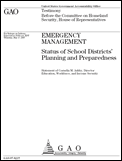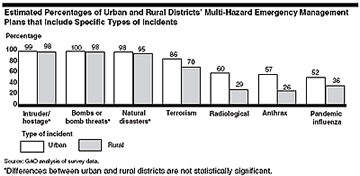GAO Report Confirms Collaboration Needs Improvement

"Emergency planning is a community endeavor. All organizations at all levels must be involved — schools and school districts, local law enforcement and emergency responders, state and federal emergency management. A collaborative effort can ease the burden on any one group. By working together, we maximize efficiencies and create an environment of high achievement." – Vincent J. Bove
There is only one way to get the job of emergency planning done right and that is by working together. A recently released report by the U.S. Government Accountability Office stated that, "Fewer than half of districts with emergency plans involve community partners when developing and updating these plans."
I implore all schools, school districts and community organizations to exert a full force effort to develop, update, implement and practice their emergency plans. Disasters don't have a schedule, so let's begin today to make a difference.
[Reprinted from the GAO Highlights on EMERGENCY MANAGEMENT: Status of School Districts’ Planning and Preparedness – http://www.gao.gov/docsearch/abstract.php?rptno=GAO-07-821T]
EMERGENCY MANAGEMENTStatus of School Districts’ Planning and Preparedness
School districts have taken steps to plan for a range of emergencies, as most have developed multi-hazard emergency management plans; however some plans and activities do not address federally recommended practices. For example, based on GAO’s survey of a sample of public school districts, an estimated 56 percent of all school districts have not employed any procedures in their plans for continuing student education in the event of an extended school closure, such as might occur during a pandemic, and many do not include procedures for special needs students. Fewer than half of districts with emergency plans involve community partners when developing and updating these plans. Finally, school districts are generally not training with first responders or community partners on how to implement their school district emergency plans.
 Many school district officials said that they experience challenges in planning for emergencies and some school districts face difficulties in communicating and coordinating with first responders and parents, but most said that they do not experience challenges in communicating with students. For example, in an estimated 62 percent of districts, officials identified challenges stemming from a lack of equipment, training for staff, and personnel with expertise in the area of emergency planning as obstacles to implementing recommended practices.
Many school district officials said that they experience challenges in planning for emergencies and some school districts face difficulties in communicating and coordinating with first responders and parents, but most said that they do not experience challenges in communicating with students. For example, in an estimated 62 percent of districts, officials identified challenges stemming from a lack of equipment, training for staff, and personnel with expertise in the area of emergency planning as obstacles to implementing recommended practices.
READ MORE
| U.S. Government Accountability Office Emergency Management: Status of School Districts' Planning and Preparedness |
Click here to visit site |
Labels: Emergency Preparedness, School Violence




0 Comments:
Post a Comment
<< Home